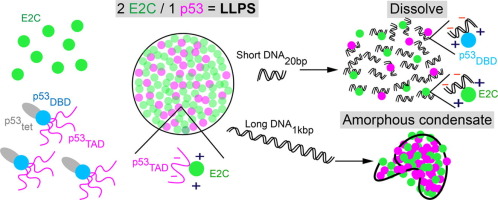Journal of Molecular Biology, Available online 17 November 2022, 167889, 2022
Highlights
- HPV replication is repressed by p53 through interaction with the E2 master regulator.
- E2-p53 interaction takes place through a finely tuned biomolecular condensate.
- This condensate is either dissolved or reshaped depending on the length of DNA added.
- E2 recruits p53 to chromatin in cells.
- Condensation of p53 with a DNA tumour virus regulator linked to viral replication.
Abstract
p53 exerts its tumour suppressor activity by modulating hundreds of genes and it can also repress viral replication. Such is the case of human papillomavirus (HPV) through targeting the E2 master regulator, but the biochemical mechanism is not known. We show that the C-terminal DNA binding domain of HPV16 E2 protein (E2C) triggers heterotypic condensation with p53 at a precise 2/1 E2C/p53 stoichiometry at the onset for demixing, yielding large regular spherical droplets that increase in size with E2C concentration. Interestingly, transfection experiments show that E2 co-localizes with p53 in the nucleus with a grainy pattern, and recruits p53 to chromatin-associated foci, a function independent of the DNA binding capacity of p53 as judged by a DNA binding impaired mutant. Depending on the length, DNA can either completely dissolve or reshape heterotypic droplets into irregular condensates containing p53, E2C, and DNA, and reminiscent of that observed linked to chromatin. We propose that p53 is a scaffold for condensation in line with its structural and functional features, in particular as a promiscuous hub that binds multiple cellular proteins. E2 appears as both client and modulator, likely based on its homodimeric DNA binding nature. Our results, in line with the known role of condensation in eukaryotic gene enhancement and silencing, point at biomolecular condensation of E2 with p53 as a means to modulate HPV gene function, strictly dependent on host cell replication and transcription machinery.
Keywords
Human papillomavirusE2 DNA binding domainp53LLPSViral protein

